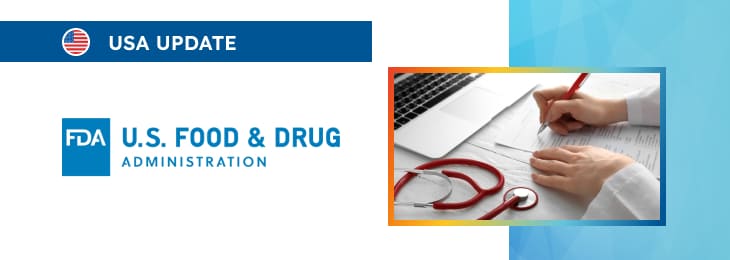The article highlights the key points related to the submissions associated with novel medical devices intended to be marketed and used in the US.

Table of content
The Food and Drug Administration (FDA or the Agency), the US regulating authority in the sphere of healthcare products, has published a guidance document dedicated to the electronic submission template for medical device De Novo requests. The document provides an overview of the applicable regulatory requirements, as well as additional clarifications and recommendations to be taken into consideration by medical device manufacturers and other parties involved in order to ensure compliance.
At the same time, provisions of the guidance are non-binding in their legal nature, nor are they intended to introduce new rules or impose new obligations. Moreover, the authority explicitly states that an alternative approach could be applied, provided such an approach is in line with the existing legal framework and has been agreed with the authority in advance.
The FDA has released the present guidance in order to introduce submitters of De Novo requests to the electronic submission process. In particular, this guidance is intended to support the Center for Devices and Radiological Health (CDRH) and the Center for Biologics Evaluation and Research (CBER) in implementing electronic submissions for De Novo classification requests.
This initiative is part of the FDA’s broader commitment to improving submission consistency and efficiency through the development of electronic submission templates. These templates are designed to serve as guided tools for industry professionals, helping to streamline the preparation and review of submissions.
The guidance is aligned with the FDA’s mandate under section 745A(b) of the Federal Food, Drug, and Cosmetic Act (FD&C Act), which was amended by section 207 of the FDA Reauthorization Act of 2017 (FDARA). This mandate requires the establishment of standards for electronic submissions, including a timetable for their implementation and criteria for waivers and exemptions.
The document provides specific instructions and standards for De Novo electronic submissions, ensuring that the FDA requirements are met effectively.
Regulatory Background
Section 745A(b) of the FD&C Act, as amended by FDARA, mandates that certain pre-submissions and submissions related to medical devices must be made in an electronic format specified by the FDA. This includes submissions under various sections of the FD&C Act and the Public Health Service Act.
The FDA was required to issue draft guidance on electronic submission standards by October 1, 2019, and final guidance within a year of the public comment period’s closure. The Medical Device User Fee Amendments of 2017 (MDUFA IV) further committed the FDA to developing electronic submission templates, with the aim of improving submission consistency and review efficiency.
This commitment was reaffirmed in the Medical Device User Fee Amendments of 2022 (MDUFA V). To implement this initiative, the FDA piloted the use of the electronic Submission Template And Resource (eSTAR) for 510(k) submissions.
The pilot program began in February 2020, and by September 2020, the eSTAR template was available for voluntary use by all 510(k) submitters. Mandatory use of the eSTAR template for 510(k) submissions began in October 2023. The eSTAR template was later expanded to include De Novo requests, which became available for voluntary use in January 2022.

Scope of the Guidance
This guidance document specifically addresses the technical standards required for the preparation of electronic submission templates for De Novo classification requests. These templates are designed to facilitate the submission process by ensuring that all necessary elements are included and properly organized.
The eSTAR template, currently the only available tool for De Novo electronic submissions, provides guided prompts to help submitters assemble a complete and compliant submission. While the guidance does not detail the user interface or specific content of the eSTAR template, it establishes the electronic format and standards necessary to comply with section 745A(b)(3) of the FD&C Act.
The FDA plans to update the eSTAR template as relevant policies evolve and continues to seek public comments and stakeholder feedback to refine the submission process.
Key Considerations
The guidance outlines the statutory requirements for electronic submissions, as specified in section 745A(b) of the FD&C Act. Submitters are encouraged to use the eSTAR template to comply with these requirements, ensuring that their submissions are consistent with the standards recognized by the FDA.
The document also provides criteria for waivers and exemptions from the electronic submission requirements. Submitters seeking alternative approaches must demonstrate that their methods satisfy the applicable statutes and regulations.
The FDA is open to discussing alternative approaches with submitters, provided that these alternatives meet the necessary legal and regulatory standards. The FDA has established a timetable for the mandatory use of electronic submission templates, beginning with the mandatory use of eSTAR for 510(k) submissions in October 2023.
The timeline for De Novo submissions is currently in a voluntary phase, with a mandatory phase expected to follow based on the FDA’s ongoing evaluation and policy updates. The FDA actively solicits public comments and stakeholder feedback to improve the electronic submission process.
This feedback is considered in the development of new versions of the eSTAR template and other related policies. The FDA’s website provides additional information on how stakeholders can participate in this ongoing process.
Conclusion
In summary, the present FDA guidance on electronic submission templates for De Novo requests marks a significant step towards enhancing the efficiency and consistency of medical device submissions. As the FDA continues to refine these processes, it remains committed to engaging with stakeholders and updating the electronic submission tools to reflect the latest regulatory standards and industry needs.
How Can RegDesk Help?
RegDesk is an AI-powered Regulatory Information Management System that provides medical device companies with regulatory intelligence for over 120 markets worldwide. It can help you prepare and publish global applications, manage standards, run change assessments, and obtain real-time alerts on regulatory changes through a centralized platform. Global expansion has never been this simple.

